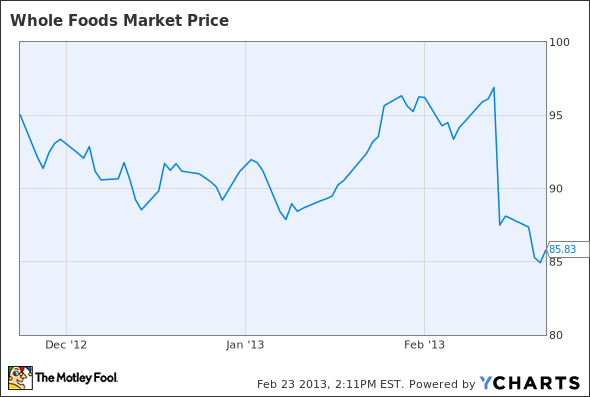A happy customer is a repeat customer, willing to pay a higher price for a superior experience. This is how Whole Foods Market, Inc. (NASDAQ:WFM) operates its business. Grocery shopping at supermarkets long ago became an unpleasant chore, full of apathetic teenage workers making minimum wage and, depending on the supermarket, sometimes unclean conditions. In exchange for this misery prices are low, attracting the most dollar-conscious shoppers. Of course, some supermarkets are better than others, but there’s very little customer loyalty. Often people simply go where the prices are the lowest, thus driving margins lower and lower.


WFM Gross Profit Margin Quarterly data by YCharts
What’s more, while competitors have seen their gross margins decline over the past decade Whole Foods has kept it essentially flat. This would suggest that the company is carving out a moat in the supermarket industry. Operating margin tells a similar story.

WFM Operating Margin TTM data by YCharts
Whole Foods has managed to recover from the financial crisis and push operating margins above pre-crisis levels, while competitors’ operating margins continue to decline. Whole Foods’ operating margin is almost three times that of Safeway and four times that of Kroger.
Earning below expectations
Earlier this month Whole Foods reported its quarterly earnings, with EPS and revenue in line with analyst estimates. However, same store sales came in at 7.2%, below the consensus estimate of 7.7%. This sent the shares tumbling, falling from around $96 to around $85.

Analysts are wrong more often than they’re right, so the fact that the market responds so violently to a miss like this is beyond me. But this drop in price may open an opportunity to buy Whole Foods at a discount. A growth stock like this is more difficult to value than a slow-growing company, so estimates will be inherently rough. I’ll start with the balance sheet.
The balance sheet
At the end of the most recent quarter Whole Foods has $1.13 billion in cash and investments and no debt. With a diluted share count of 188 million the company has just over $6 in net cash per share. This net cash position gives Whole Foods the ability to expand the store count rapidly without taking on debt. With a share price around $86 the market is valuing all of Whole Foods’ future profits at $80 per share.
Profits
Whole Foods has grown its EPS from $0.82 in fiscal 2008 to $2.52 in fiscal 2012, a 200% increase or about 32% annualized. Free cash flow per share has jumped from $-1.41 to $3.97 in that same time. This was fueled by annualized revenue growth of about 10%.
This growth was driven by both new store openings and by same-store sales growth. The company expects to open between 32 and 34 stores in fiscal 2013, which would increase its store count by almost 10%. In addition, the company has guided for same-store sales growth to be between 6.6% and 8% and EPS between $2.83 and $2.87. This would represent EPS growth of 12.3% on the low end.
After subtracting the net cash, Whole Foods trades at about 31 times 2012 earnings and about 20 times 2012 free cash flow.
The company has stated that 1,000 stores is a reasonable goal, so with only 345 stores so far the company can grow its store count by 10% annually for 11 years before reaching this goal.
Data from Morningstar
Is Whole Foods a Buy?
Even after the drop in stock price I think that Whole Foods is still too expensive — 31 times earnings is a high price to pay for 12% EPS growth going forward. For earnings to grow faster the operating margin would need to grow, not unreasonable given that its grown over the last few years.
If revenue grows by 12% per year over the next 11 years while operating margin rises from 6.4% to 8%, revenue would sit at $40.7 billion with EBIT at $3.26 billion. Assuming a 35% tax rate net income would be $2.12 billion. Since meaningful store growth would stop at this point growth would slow down considerably. A P/E ratio of 20 would value the company at $42.4 billion. This is 165% market cap growth in 11 years, or 9.3% annualized.
This is not a terrible result, but remember that I assumed that operating margins increase. Without that condition annualized market cap growth drops to 7.1%.
All this assumes that revenue consistently grows by 12% each year for more than a decade and that Whole Foods can at least maintain its margins. The supermarket industry is extremely competitive, and projecting anything that far in advance is a difficult prospect. If everything goes right for Whole Foods, its not an unreasonable buy at the current price. But there’s no margin of safety here. If growth starts to slow then the stock will plummet. In this case I think the risks outweigh the rewards.
The article Is This Stock a Buy After Earnings Miss? originally appeared on Fool.com and is written by Timothy Green.
Copyright © 1995 – 2013 The Motley Fool, LLC. All rights reserved. The Motley Fool has a disclosure policy.




